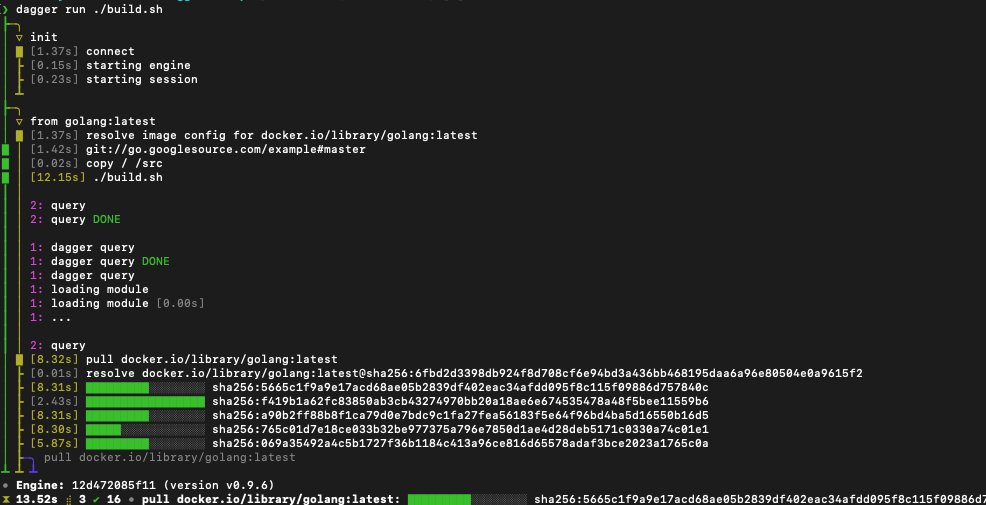Build your modern software factory.
Build your modern software factory.
Build your modern software factory.
Define software delivery workflows and dev environments with reusable components — including LLMs — and run them anywhere. Built by the creators of Docker.
Define software delivery workflows and dev environments with reusable components — including LLMs — and run them anywhere. Built by the creators of Docker.
Define software delivery workflows and dev environments with reusable components — including LLMs — and run them anywhere. Built by the creators of Docker.
brew install dagger/tap/dagger



Building Blocks
Components for modern software and workflows
Components for modern
software and workflows
Components for modern
software and workflows
Turn
containers
,
LLMs
,
files
,
repositories
,
directories
,
and more into programmable and stateful objects. Get full type safety across with a consistent interface that works in any supported language.
Chain functions to do anything, anywhere
Chain functions to do anything, anywhere
Chain functions to do anything, anywhere
Write function chains that work consistently anywhere. Functions automatically cache results and maintain pure state between runs—no more rebuilding what hasn't changed.
Write function chains that work consistently anywhere. Functions automatically cache results and maintain pure state between runs—no more rebuilding what hasn't changed.
Go
Python
TypeScript
func (m *Api) Run(dir *dagger.Directory, db *dagger.Service) *dagger.Service { return dag.Container(). From("alpine:latest"). WithServiceBinding("db", db). WithMountedDirectory("/app", dir). WithWorkdir("/app"). AsService(dagger.ContainerAsServiceOpts{ Args: []string{"go", "run", "/app/main.go"}, }) }
Go
Python
TypeScript
func (m *Api) Run(dir *dagger.Directory, db *dagger.Service) *dagger.Service { return dag.Container(). From("alpine:latest"). WithServiceBinding("db", db). WithMountedDirectory("/app", dir). WithWorkdir("/app"). AsService(dagger.ContainerAsServiceOpts{ Args: []string{"go", "run", "/app/main.go"}, }) }
Go
Python
TypeScript
func (m *Api) Run(dir *dagger.Directory, db *dagger.Service) *dagger.Service { return dag.Container(). From("alpine:latest"). WithServiceBinding("db", db). WithMountedDirectory("/app", dir). WithWorkdir("/app"). AsService(dagger.ContainerAsServiceOpts{ Args: []string{"go", "run", "/app/main.go"}, }) }
Go
Python
TypeScript
func (m *Api) Run(dir *dagger.Directory, db *dagger.Service) *dagger.Service { return dag.Container(). From("alpine:latest"). WithServiceBinding("db", db). WithMountedDirectory("/app", dir). WithWorkdir("/app"). AsService(dagger.ContainerAsServiceOpts{ Args: []string{"go", "run", "/app/main.go"}, }) }
Open Platform
Get everything you need to ship fast, with confidence
Add capability, control, predictability, and observability to your workflows or AI coding agents — without adding more to your plate.
CLI & SDKs
Rapidly prototype, develop, and ship
Prototype, test, debug, and ship interactively and quickly through your terminal. Write applications in Python, TypeScript, Go, or any language you prefer with type-safe connections. Mix components across language ecosystems.
CLI & SDKs
Rapidly prototype, develop, and ship
Prototype, test, debug, and ship interactively and quickly through your terminal. Write applications in Python, TypeScript, Go, or any language you prefer with type-safe connections. Mix components across language ecosystems.
CLI & SDKs
Rapidly prototype, develop, and ship
Prototype, test, debug, and ship interactively and quickly through your terminal. Write applications in Python, TypeScript, Go, or any language you prefer with type-safe connections. Mix components across language ecosystems.
CLI & SDKs
Rapidly prototype, develop, and ship
Prototype, test, debug, and ship interactively and quickly through your terminal. Write applications in Python, TypeScript, Go, or any language you prefer with type-safe connections. Mix components across language ecosystems.
LLMs
Make agents that run free, not wild
Add agentic capabilities into your workflows, or give agents the perfect environment and set of tools so they can do their magic without wreaking havoc.
LLMs
Make agents that run free, not wild
Add agentic capabilities into your workflows, or give agents the perfect environment and set of tools so they can do their magic without wreaking havoc.
LLMs
Make agents that run free, not wild
Add agentic capabilities into your workflows, or give agents the perfect environment and set of tools so they can do their magic without wreaking havoc.
LLMs
Make agents that run free, not wild
Add agentic capabilities into your workflows, or give agents the perfect environment and set of tools so they can do their magic without wreaking havoc.
Tracing
See every step
Built-in tracing, logs, and metrics that show exactly what's happening at every step. Debug complex agent interactions immediately instead of guessing what went wrong.

Tracing
See every step
Built-in tracing, logs, and metrics that show exactly what's happening at every step. Debug complex agent interactions immediately instead of guessing what went wrong.

Tracing
See every step
Built-in tracing, logs, and metrics that show exactly what's happening at every step. Debug complex agent interactions immediately instead of guessing what went wrong.

Tracing
See every step
Built-in tracing, logs, and metrics that show exactly what's happening at every step. Debug complex agent interactions immediately instead of guessing what went wrong.

Engine
Run it on any platform, any language
Containerized execution runtime that creates cacheable, reproducible operations. Works with any compute platform or tech stack, automatically optimizing for speed and cost.

Engine
Run it on any platform, any language
Containerized execution runtime that creates cacheable, reproducible operations. Works with any compute platform or tech stack, automatically optimizing for speed and cost.

Engine
Run it on any platform, any language
Containerized execution runtime that creates cacheable, reproducible operations. Works with any compute platform or tech stack, automatically optimizing for speed and cost.

Engine
Run it on any platform, any language
Containerized execution runtime that creates cacheable, reproducible operations. Works with any compute platform or tech stack, automatically optimizing for speed and cost.

Modules
Share & Reuse
Build reusable modules to share with your team or grab existing ones from the Daggerverse — stop coding the same automation patterns from scratch.




Examples
Examples
See Dagger in action
Components for modern
software and workflows
Explore projects built with Dagger, for inspiration or a quick start.

Lee Gaines
Principal Engineer
It's kind of a container-based swiss army knife that can be used for CI operations (reproducible builds, testing, publishing), creating LLM agents, and more. Tons of integrations and open-source modules on the "Daggerverse".

Jordan Parker
When @solomonstre drops an open-source Claude Code... ya run with it. "Toy Programmer" + added MCP & cursor-rules + an updated version of @zbeyens phenom "dotai" repo

Kyle Penfound
This is so awesome to play with. I just made a new frontend for my main demo repo without any hand-holding, writing integrations, or anything. Just core dagger + bring your own LLM. In a 2 minute video. Most of which is for the sake of the recording

Benjie D.
So im finally coming around on this whole AI thing is the future...Solomon Hykes demo of an agent writing a curl clone in 5 minutes using Dagger is still lingering in my mind...if any of you are curmudgeons like me you might want to watch...

Yves
If you don’t know where to start to create AI agents, you should have a look at Dagger agents. That makes it so easy to build tools that will benefit from AI but as real developer tool.

Steeve Morin
Few understand the implications of this. This will be absolutely defining

Alberto Fuentes
I'm feeling a "docker moment" in real time. Even though I didn't know the CI tool, it seems so promising for multiple areas.

Matias Pan
@dagger_io experimental AI tooling is really interesting. I just leveraged two separate modules (Strava and Notify). It took me 20 minutes to build the prompt and less than 5 to write the code.

Ankur Duggal
This is crazy cool! If you have worked with LLMs this is amazing!

Peter Jausovec
all your dagger functions are now available for agents to use. built-in function registry.

Madhav Jivrajani
This is nuts. @dagger_io has always had amazing dev exp, but the fact that it lends itself so seamlessly to something like this is endlessly impressive, massive props @solomonstre and the team!

Austen
Ok, my mind is a little blown right now. I never considered having LLMs accept containers as inputs and then interact with them to accomplish some goal.

Adrian Duermael
CEO at Cubzh
That's why tools like @dagger_io are going to be so powerful! (standardized text interface, multi-language modules and a neatly integrated web GUI over the CLI) Great AI assistant experiences largely depend on well-designed interfaces they can easily leverage.

Steeve Morin
Founder of ZML
I think few realize where Dagger sits in the agentic race. I know I didn’t until I was shown. Incredible.

Corentin Kerisit
If you can relate, you need @dagger_io and fast.

Pedro Piñera
Founder, CEO - Tuist
It’ll take time for people to realize the value of @dagger_io but I’m optimistic it’ll reach critical mass and break the vendor locking that many CI providers benefited from for many years.

Pedro Piñera
Founder, CEO - Tuist
I just tried to set up a CI pipeline using @dagger_io to compile and test an Elixir project and OMG. The portability is so priceless. Blog post in progress 😀

David Flanagan
My entire CI/CD pipeline is Dagger and I'd love for dev to be too; still a few changes that need to happen there though.
Watch this space 😃

Edouard Bonlieu
Co-founder @gokoyeb , deploy apps and databases on high-performance infrastructure around the world. Previously built @scaleway
Excited to hear @solomonstre talking about @dagger_io and Dagger functions. Need to push the @gokoyeb function to the Daggerverse

Zhipeng Huang
Open Source Effectively Accelerates !
It was great to participate @dagger_io Meetup yesterday, one of the purest form of OSS event: no bullshit, minimal slides, maximum code. @solomonstre might gave away his @KubeCon_ KN magic a bit
, but it was really fun.

Diego Ciangottini
Technologist
🚀 My top pick video from hashtag#KubeCon + hashtag#cloudnative in Paris is out! From integrated environments to innovative approaches, there's something for every science community to keep an eye on.
YOU get to choose what we dive into next! Comment with your preference!
https://lnkd.in/d2Xj2DhJ
1️⃣ First up, Kubeflow offers an all-in-one solution for data science workflows on Kubernetes. Check out CERN Computing's experience at the hashtag#cloudnativeAIDay event and the DHL Data & Analytics and their journey to a data science platform.
2️⃣ Impressive NATS.io with a demo by Synadia perfect for applications from hashtag#ai / hashtag#ml on IoT to microservices
3️⃣ Discover Dagger Functions, revolutionizing workflow management for reproducibility and interoperability
Plus, an extra shoutout to the Cloud Native Computing Foundation (CNCF) Enduser Research, let's push it together as it should be!
Dany Camirand
Conseiller intégrateur en architecture logicielle (Cloud/DevOps) chez Ministère de la Famille du Québec (MFA)
What I also like 👌 about Dagger is that it perfectly aligns with my personal fav quote:
'Localhost is your best cloud provider’ 🔥🚀
https://dagger.io
Ivan Velichko
Software Engineer
What Is Dagger and Why You Might Want to Use It 🧵
Dagger promises to fix our CI/CD once and for all, but what exactly is Dagger?
Is it a GitHub Actions or Jenkins replacement? Or is it a dev tool that augments existing CI/CD providers? Is it a service or a CLI?
My take 👇

Utsab Sapkota
DevOps and Cloud
Just finished an incredible hands-on session with Saiyam Pathak, Solomon Hykes, and Kyle Penfound on the Kubesimplify channel, diving deep into the powerful tool Dagger. Followed along on my personal computer and learned a ton. Highly recommend checking it out for anyone interested in cutting-edge DevOps! hashtag#Dagger hashtag#DevOps hashtag#Kubesimplify
https://lnkd.in/dygitKgn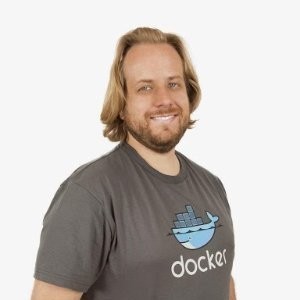
Brian Goff
Senior Software Engineer at Microsoft
I always felt like tools like docker-compose were not the right fit me me. Always required lots of glue to make it work for the things I needed to do.
This is where @dagger_io shines. Far more programatic, testable, and repeatable.

Kyle Galbraith
Co-Founder of depotdev
We released a new version of our @dagger_io Daggerverse module to bring the Depot ephemeral registry to our bake function. Going to be a game changer for building all your images at once and being able to do things with the containers immediately
https://depot.dev/changelog/2024-03-26-depot-daggerverse-1-1-0

Dipankar Das
DevOps engineer at @rtCamp | loves writing code | Founder of @ksctl_k8s
you all got me. Taskfile and Makefile now its dagger @SaiyamPathak. 🙃 Btw nice explanation on dagger. I think its a good tool, used it 1 year ago 😉 @dagger_io


Lev Lazinskiy
Technical GTM Leader
Nothing beats reading a story about Dagger from a real user. Thanks so much to Scott Molinari for sharing your experience :)
https://lnkd.in/d9fQGRg7
Sheldon Hull
expert at spline reticulation. ⚡ AWS Infinidash MVP ⚡ I ❤️ coding. Work as Senior Software Engineer.
Wrapping my head around the new functions thing is going to take a bit. But I've already done nested docker Goreleaser with CGO_ENABLED , angular builds and more with the SDK. So great! Dagger call might take over all my 3 years of mage work once I figure it all out.

John McBride
sr engineer @saucedopen 🥡 prev: AWS, VMware, Pivotal
@sheldon_hull @dagger_io and @MagefileDotOrg We’re starting to adopt dagger actually loving it so far

Neela Jacques
Former Executive Director, OpenDaylight Project, founder VSPP/vCloud @VMware , launched Cilium/Isovalent out of stealth, now helping Solomon grow http://Dagger.io
What a WILD morning! @solomonstre‘s keynote seems to have ignited something major, we’ve been swamped all morning here at @KubeCon_!
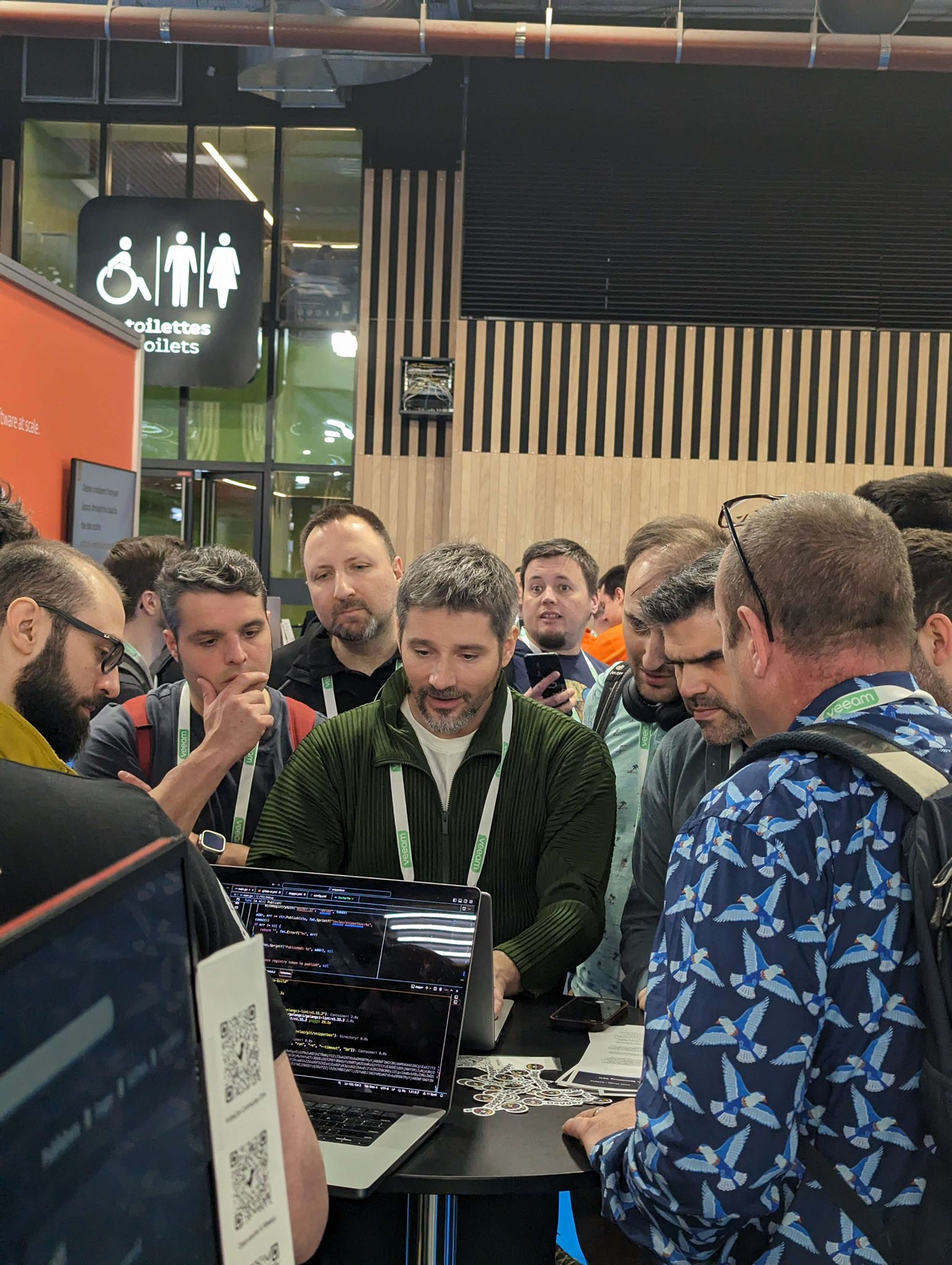

BC Gain
DevOps. Security. Observability. Linux. Kubernetes. Sailing. ReveCom Media.
Use @dagger_io to build pipelines input: @chainguard_dev's Building Container Images the Modern Way -
@chainguard_dev' s Adrian Mouat demo. It « real strength » is its modules, he said.
@KubeCon_ @linuxfoundation @thenewstack
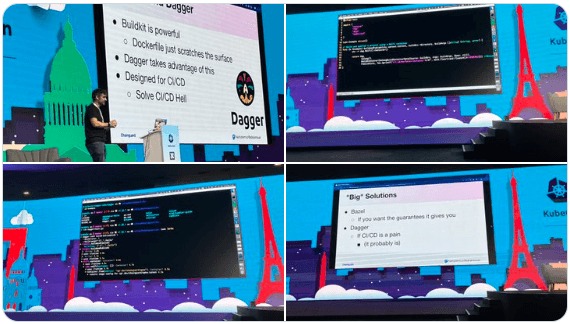
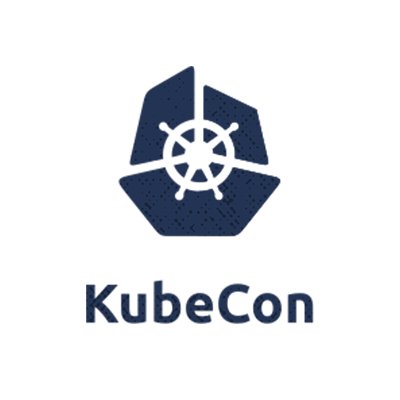
Kubecon_
The #Kubernetes & #cloudnative community conference
“It’s all about the people.” - Solomon Hykes #kubecon #cloudnativecon
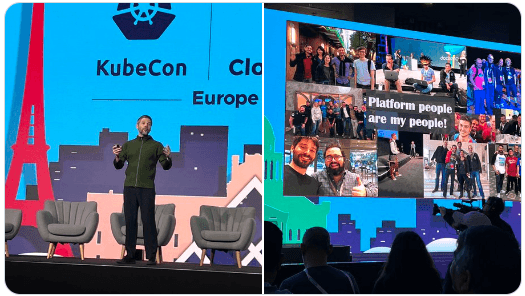
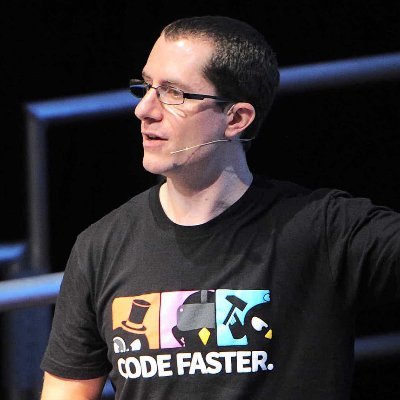
Daniel Bryant
DevRel/GTM Leader | News/Podcast @InfoQ | Web 2.0 coder, platform engineer, Java Champion, CS PhD | cloud/K8s, APIs, IPAs, running | learner/teacher
An enjoyable look back on the origins of @Docker, containers, and cloud platforms, via @solomonstre
at #KubeCon. And love the call out to “dude, where’s my platform?” Many of us are still working on this with
@dagger_io, @kratixio, #Backstage, and @CloudNativeFdn tech


Rey Lejano
CNCF Ambassador | @kubernetesio 1.23 Release Lead, 1.25 Emeritus Adviser, K8s SIG Docs co-chair | 👨🏻💻 @RedHat
#KubeCon Europe day 3 keynotes with @solomonstre from @dagger_io who helped kick off popularizing #containers and #CloudNative over a decade ago. 16 years ago, the first working build of Docker was created walking distance from #KubeCon Paris
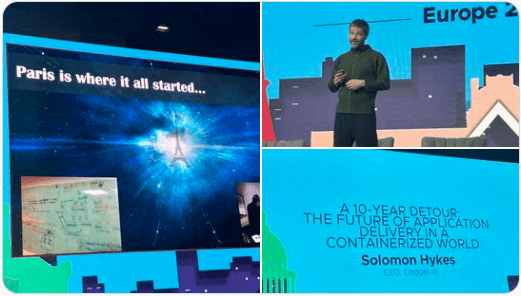

Solomon Hykes
CEO and Co-Founder, Dagger
The recording of my #kubecon keynote is out: https://youtu.be/S_Z4AHZlSUI Thank you to everyone who attended, on the last day of a draining event. It was a special moment that I enjoyed very much, I hope you did too. Non-french speakers: watch this after
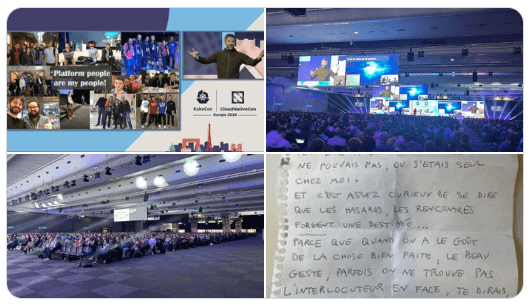

Carlos Santana
Sr. Kubernetes Specialist SA @AWSCloud | CNCF Ambassador | Kubernetes contributor
Join me at the first @dagger_io meetup in Raleigh, NC this week. The meetup will start by teaching the basics of Dagger with real-world examples. I'm still in KubeCon mode, looking forward to meeting the DevOps community in person! Check out the event details at https://meetu.ps/e/MWc2l/3Fcx2/i
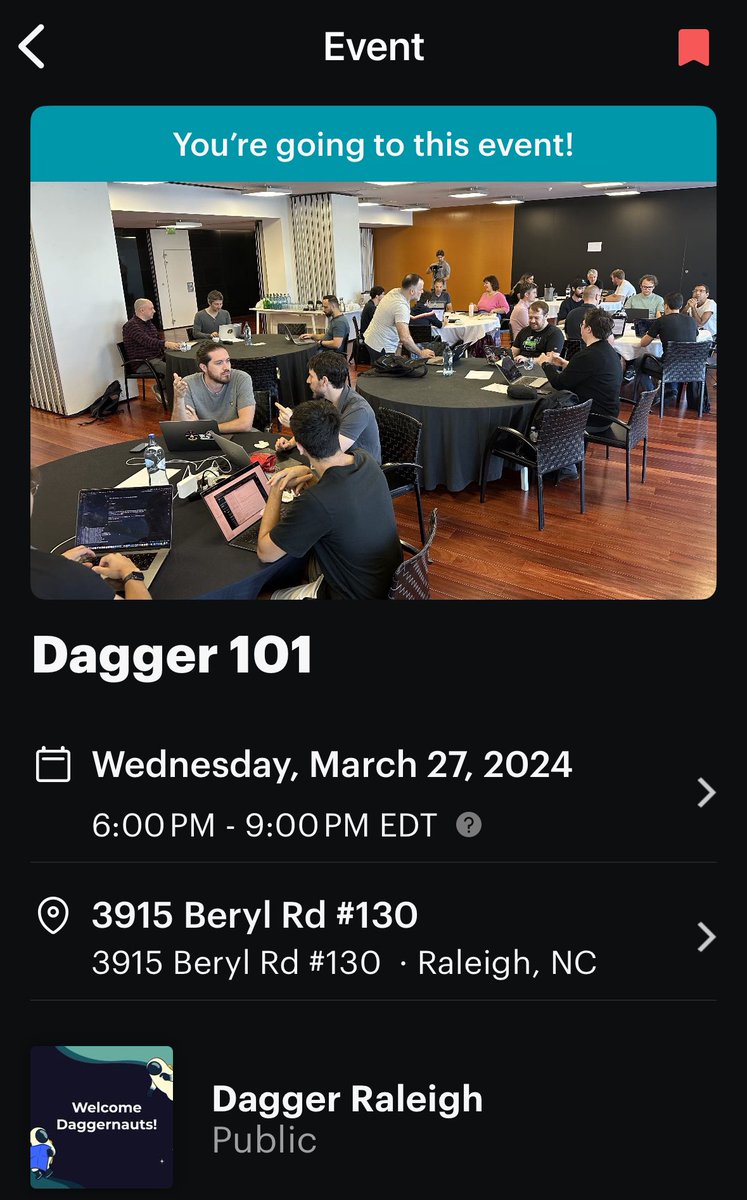

Melissa McKay
Mom. Software engineer. Author. Java Champion. Docker Captain. Dev Advocate @JFrog
Yeah... ok, there are much better foot models out there than me, but I had to show off the @dagger_io gear I brought with me from #KubeCon Chicago! Thanks for these @jpadamspdx - they were perfect for the long flight home after an incredible week at #KubeCon Paris!
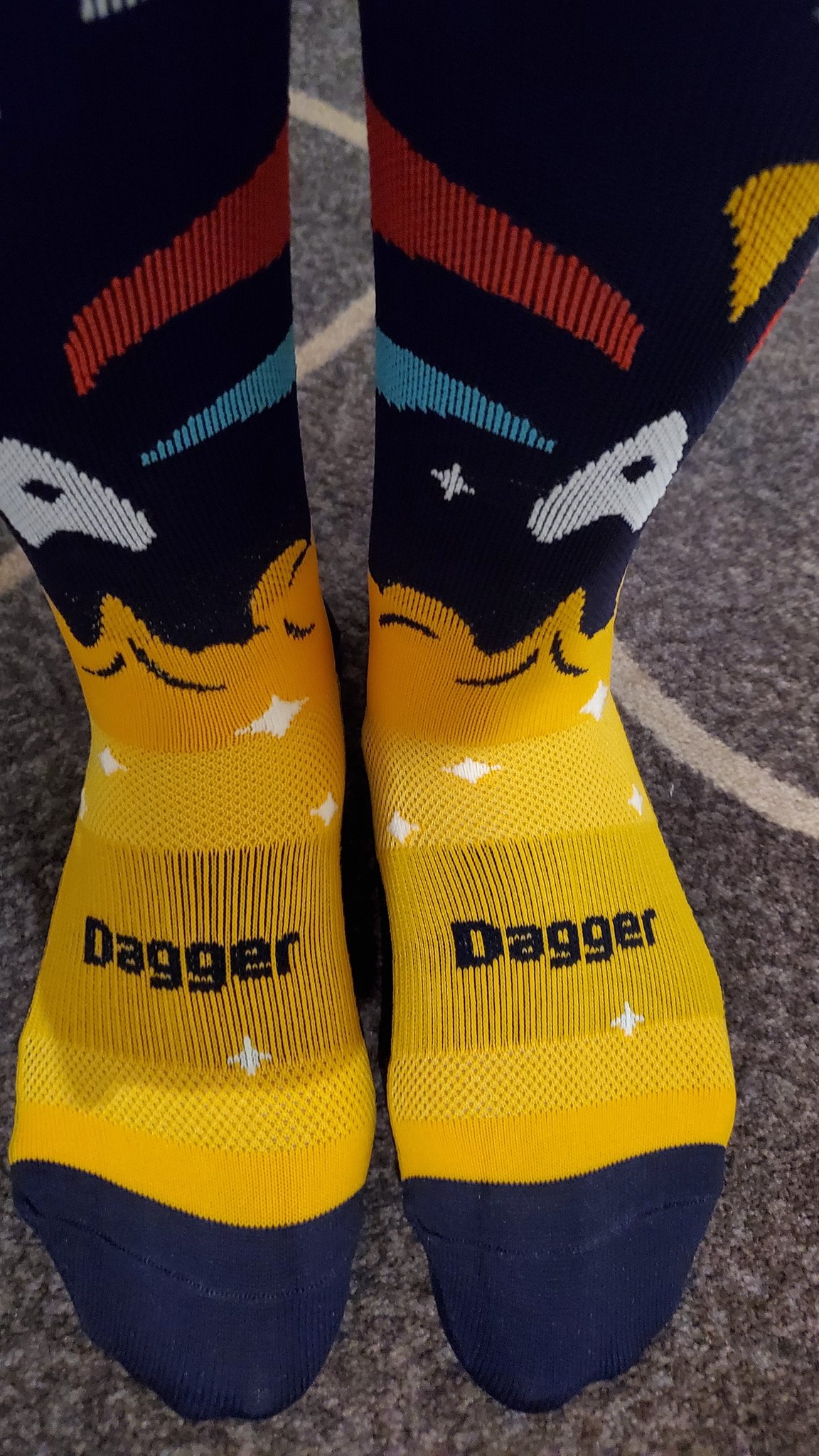

Jordi Mon Companys
PMM @chainguard_dev
@solomonstre surrounded by people at #KubeCon
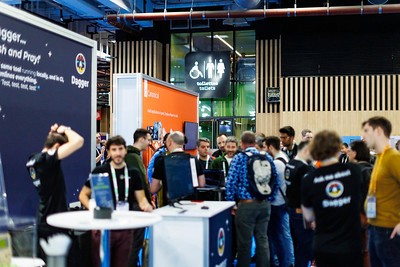

Dan Lorenc
Software Supply Chain Security
I built my first Dagger function yesterday with Solomon Hykes, and just got it published up on the daggerverse!
Dagger is awesome, and I plan on continuing to find ways to use it. At a high level, dagger lets you use containers as a first-class object in code, and stitch together complex orchestration pipelines using real programming languages instead of bash.
Primitives like mounting in files/directories, running commands, building and publishing containers, environment variables and secrets are all available, type-safe, and programmable in Go, Python, or Typescript.
Dagger functions let you build abstractions and methods on top of these basic primitives that can then be exposed and reused by other Dagger functions. The entire experience is encapsulated by the `dagger` cli, which uses magical buildkit caching and orchestrations so it's all *fassstttt*. You can run it locally or in CI systems and get the same results, and confidence that things will actually work after a push.
As self-described a yamlbash enthusiast, I'm still excited at the thought of replacing those tangled messes with real code.
Check it out here, this version is capable of building Python wheel packages across a variety of Python versions, and can handle installation of extra build-time dependencies too, for when you need some ugly cmake stuff or other native libraries. Also, it uses wolfi and Chainguard images for all the execution and package handling :)
https://lnkd.in/eDBtk7pm
#dagger #ci #opensource #wolfi #chainguard

Miguel Martinez Trivino
Co-founder at chainloop.dev
Chainloop is an Open Source Metadata Vault for your Software Supply Chain metadata, OWASP CycloneDX SBOM/xBOM Standard, SPDX SBOM, VEX, SARIF files, QA reports, and more.
From today, you can programmatically collect and enforce Software Supply Chain pieces of evidence from your Dagger pipeline!
Dagger is a great fit since it is aligned with our principle of meeting developers where they are, and you can’t get closer to them than in code, with their programming language, and in their local machine 🙂
If you want to give it a try in person, we'll also be in a couple of days at #kubecon in Paris. See you there!
Tom Hacohen
Founder & CEO at Svix
I first saw a demo of Dagger two years ago and you could sense something big was brewing.
Now with Dagger functions, it's actually happening. I just saw another demo and it really feels like something we'll all be using!
Congrats Dagger for building something special!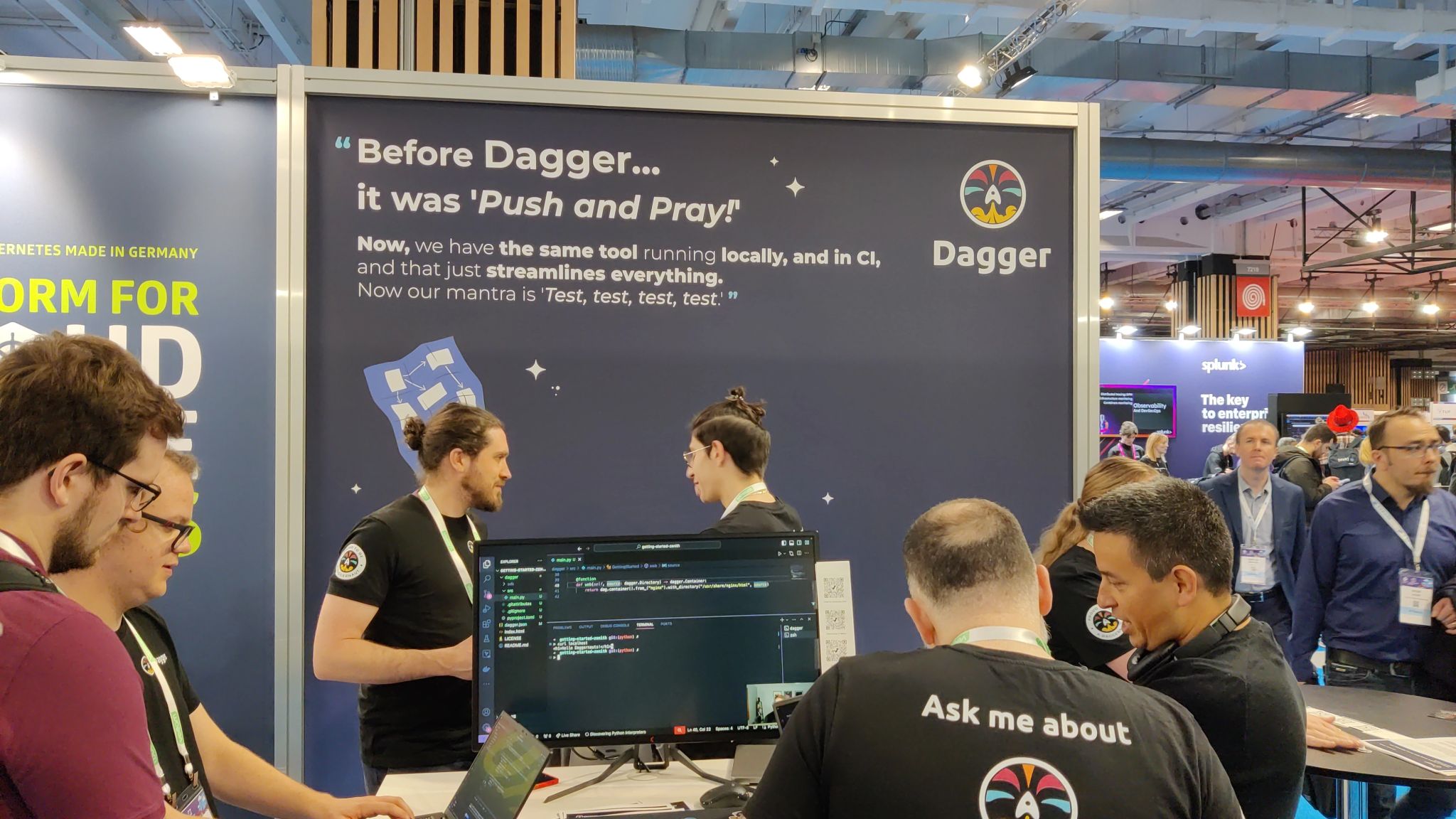

Emmanuel Sibanda
Software Engineer
Dagger is a programmable open source CI/CD engine. I built a Dagger module to solve the "but it works on my machine" problem that occurs where tests that pass locally do not pass in development because of inconsistencies in environment configurations for NodeJS applications. In this blog I detail the entire process; what I learnt through my build along with insights gained from reading Dagger docs and their Python SDK.
#Python #CICD #Jest #NodeJS #DevOps #Frontend

Oleg Šelajev
Testcontainers at Docker. Developer, author, speaker. Java Champion
Feeling productive at #kubecon with @kylepenfound. We just made a @dagger_io module to enable @Testcontainers tests easily.
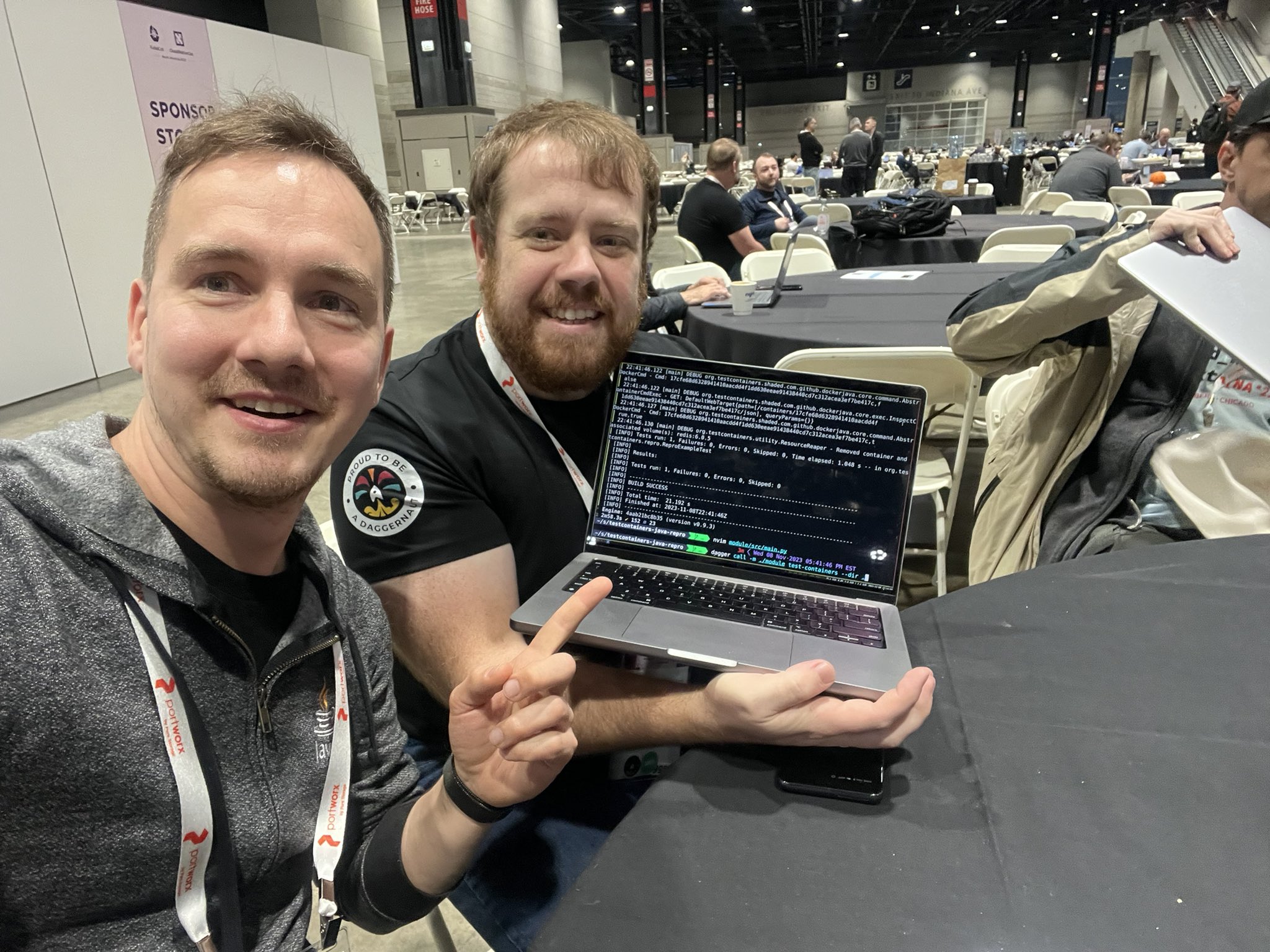

Jorge Arteiro
Cloud Developer Advocate
The one and only @solomonstre, thanks for been so welcoming. Eternally grateful for everything you did. Go @dagger_io !!!!! At #KubeCon
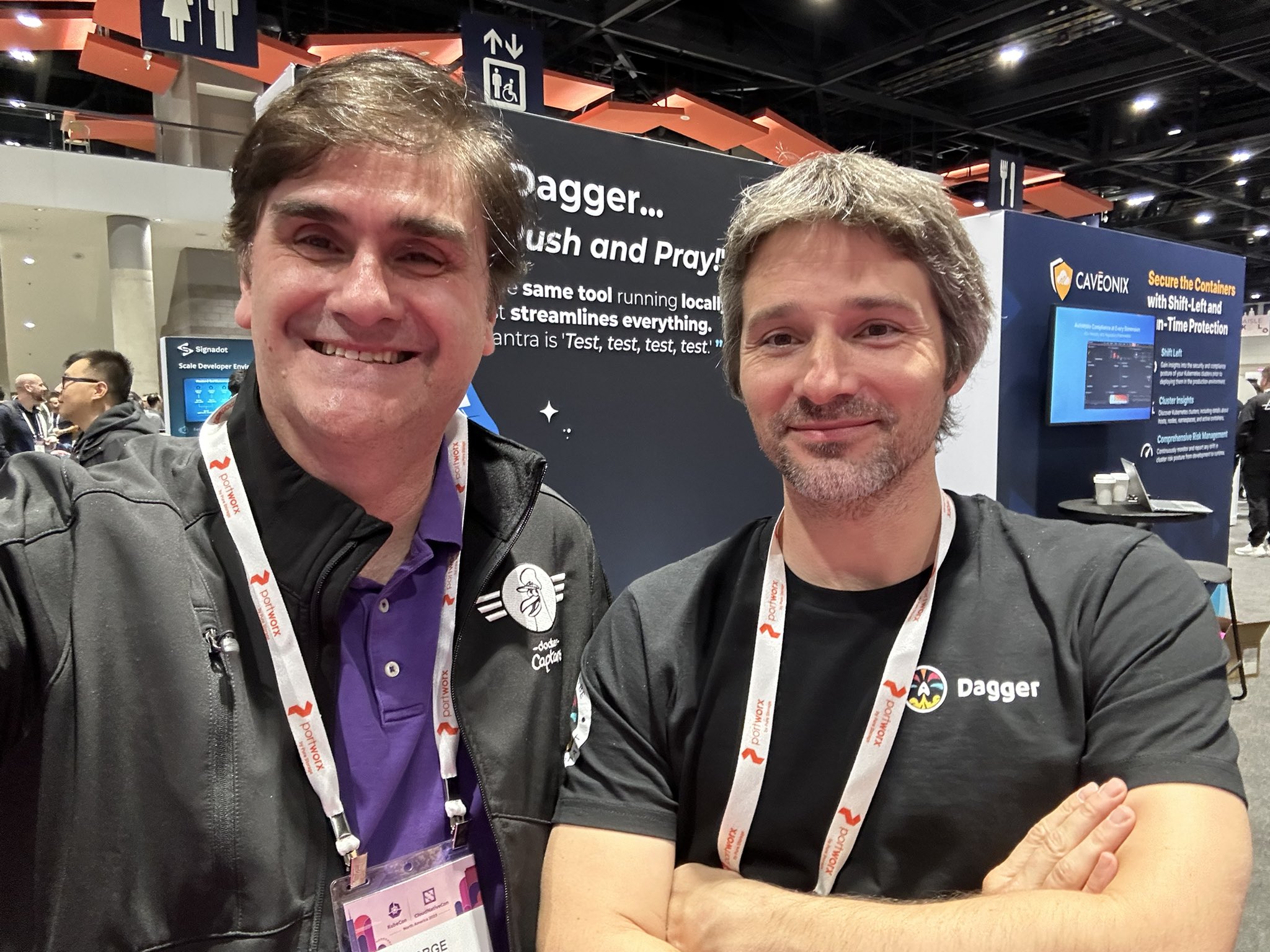

Darren Shepherd
Chief Architect & Co-Founder
Now that I understand the tao of dagger, I never want to write another dockerfile. But I have too 😢

Tsiry Sandratraina
Building fluentci_io
I finally ported some @fluentci_io modules to @dagger_io Modules
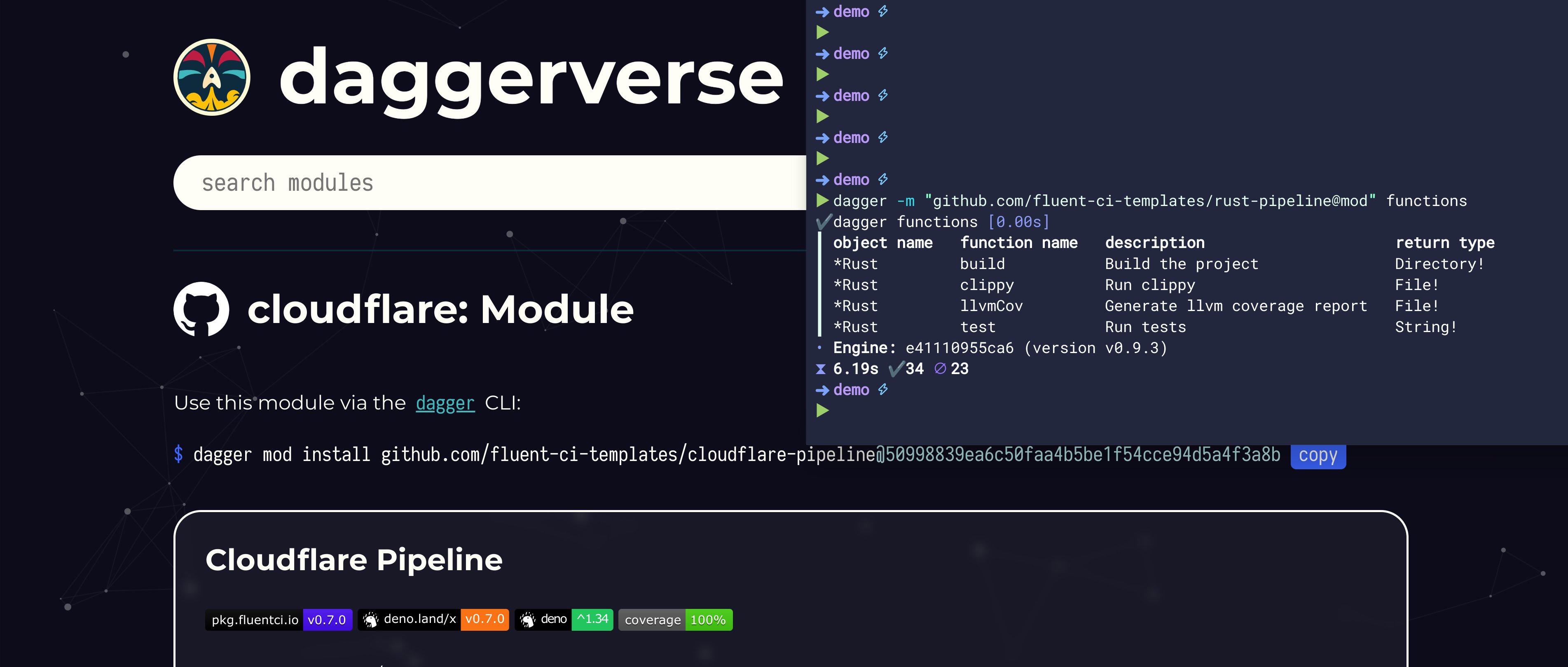

Maria Vechtomova
MLOps Tech Lead | Public speaker
It can take many "git push" to get your #cicd pipeline working.
Arne Mueller and I wrote an article about using Dagger, which you can use to run your pipelines locally and in your #cicd tool of choice:
➡ We walk through a pipeline that does unit testing, Python package building, and Docker image build and push.
➡ We show the implementation of the pipeline defined "old style" in GitHub actions, and explain how you can run it locally with act.
➡ We compare it with implementation using Dagger & very minimalistic GitHub actions.
No more "push and pray 🙏" for your #DevOps and #MLOps engineers!
Check it out on Marvelous MLOps substack: https://lnkd.in/eNcrdCiX.
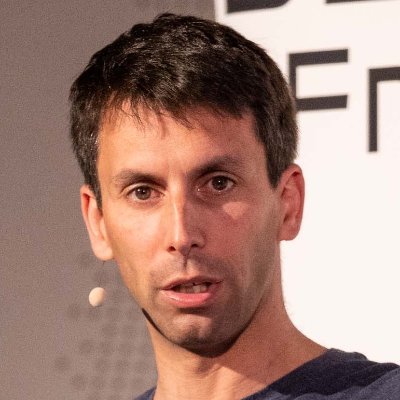
Vincent Behar
Developer
Today we had @solomonstre at the Ubisoft office - to talk about @dagger_io of course, but also our challenges. And I think he might start prototyping something soon for one of our use cases... how many CEOs do that? ;-) It was great, come back when you want!
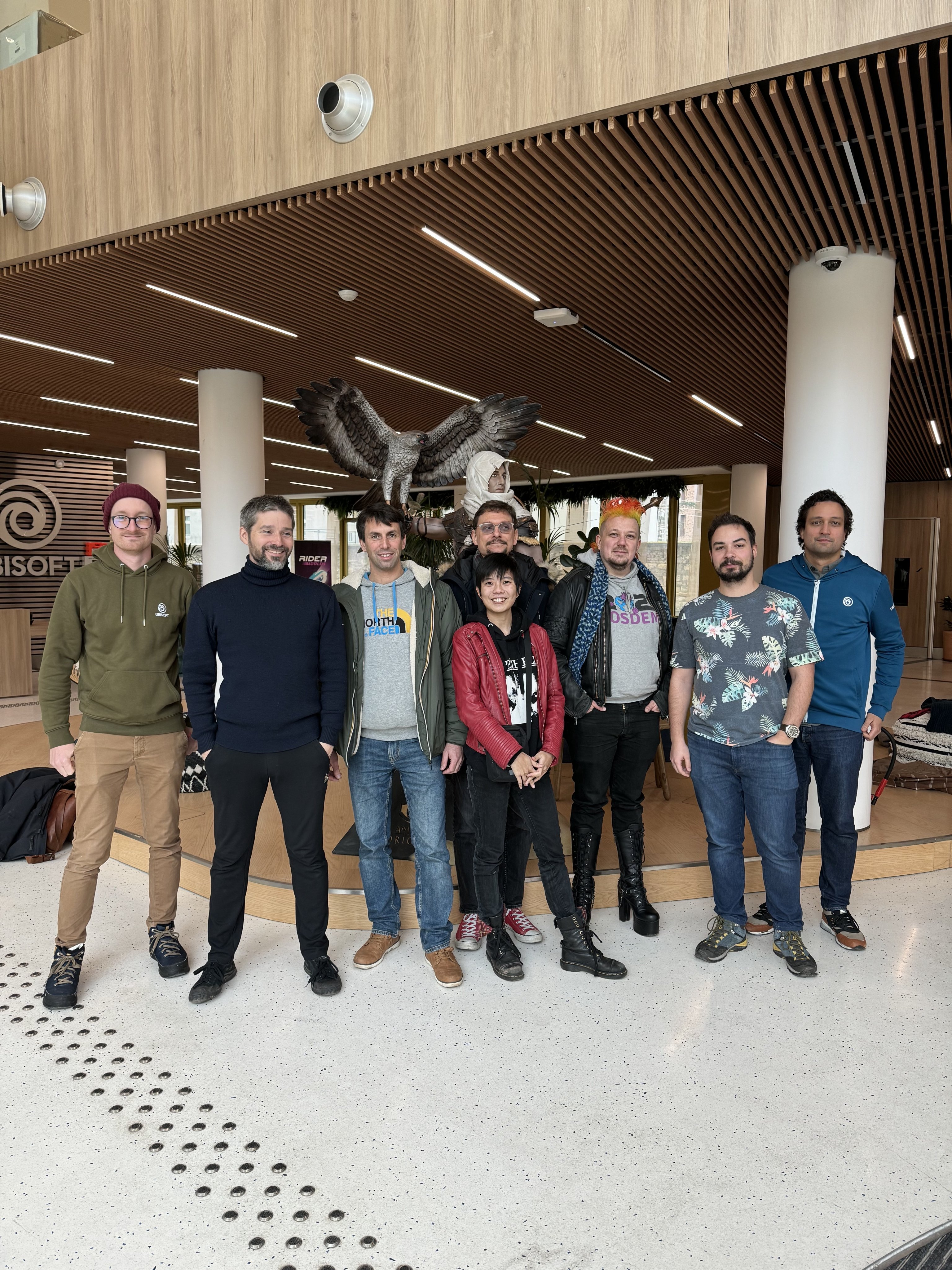

Yoofi Quansah
Advocate of better Platforms for Devs
Yeah @dagger_io killed it with writing CI pipelines as code, and being able to run that locally. I can’t think of how else you can get a similar experience except by writing a bunch of bash with Docker.
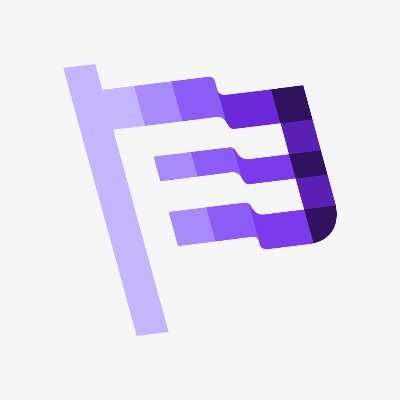
Flipt.io
There are two ways to ship code: 1. Push and Pray 2. Test, Test, Test, Test We recommend option #2. And use @dagger_io to make your life easy.

Anaïs Urlichs

Mark Robert Coleman
Co-founder & CPO of Netboxlabs
Been spending some time playing with @NetBoxOfficial @go_containerlab and @dagger_io and its pretty amazing how much can be done in the network automation space in what feels like a very cloud native way at the moment. Hoping to package it all up for a demo real soon 🚀 🚀 🚀

Sági-Kazár Márk
Head of OSS @openmeterio | Speaker, tech content creator
@dagger_io community meeting at @fosdem with @sameoldaweris


Noam Elfanbaum
Software developer
@dagger_io has replaced a combination of dockerfiles, docker-compose, and makefiles/bash scripts for me, making it easier to run CI tests locally and in GitHub actions. Great work @solomonstre!

verdverm
Unexpected surprise using @dagger_io Cloud... If you export your key from your local development environment, then all of your local build results are side-by-side with your CI build results. It's pretty great being able to recall why something failed locally and then share it

Vincent Behar
Developer
I just wrote my 1st @dagger_io modules https://github.com/vbehar/daggerverse… and the experience is really nice, thanks to the Dagger CLI. Good job guys!
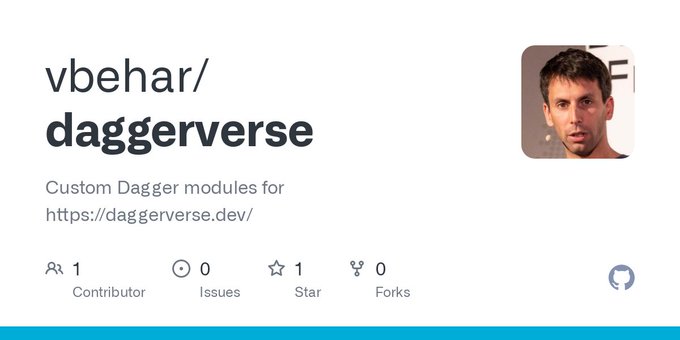
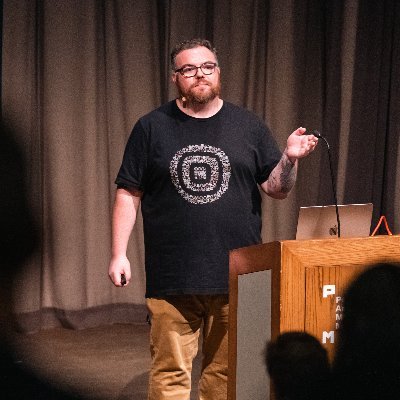
Mike Elsmore
Developer
@dr4goonis talking about stuff, @dagger_io, and CI/CD at @PHPUKConference
Warning! Live demos! #phpuk24
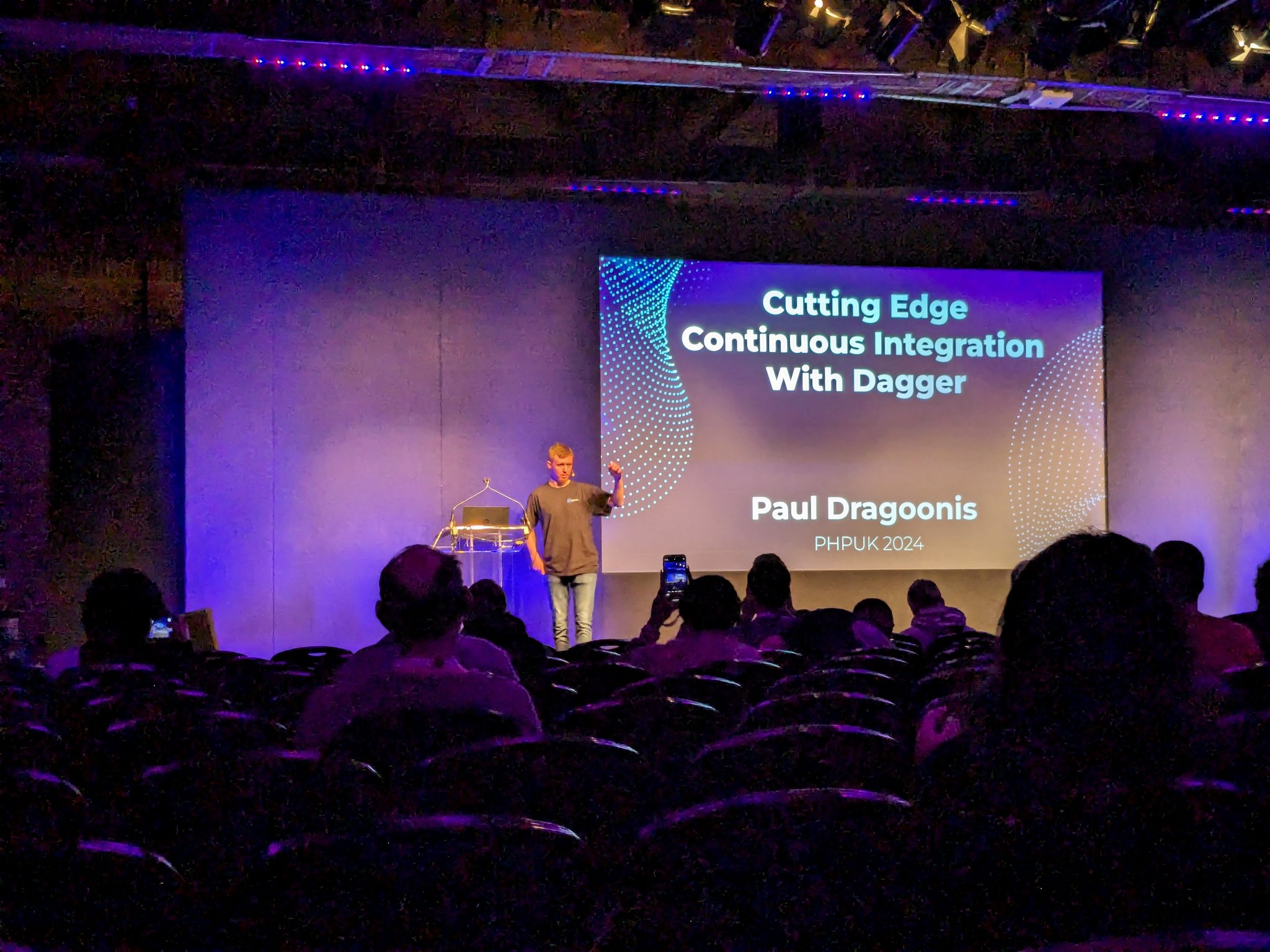

Romaric Philogène
CEO @Qovery_ - Internal Developer Platform ☁️ | Love to solve engineering problems | Rust 🦀, Kotlin, Go, Python, Java
My latest issue on why I believe @dagger_io could be the future of CI/CD for Engineering and Platform Engineering teams
https://romaricphilogene.substack.com/p/platform-tips-18-dagger-the-future
#platformengineering #cicd #devops #dagger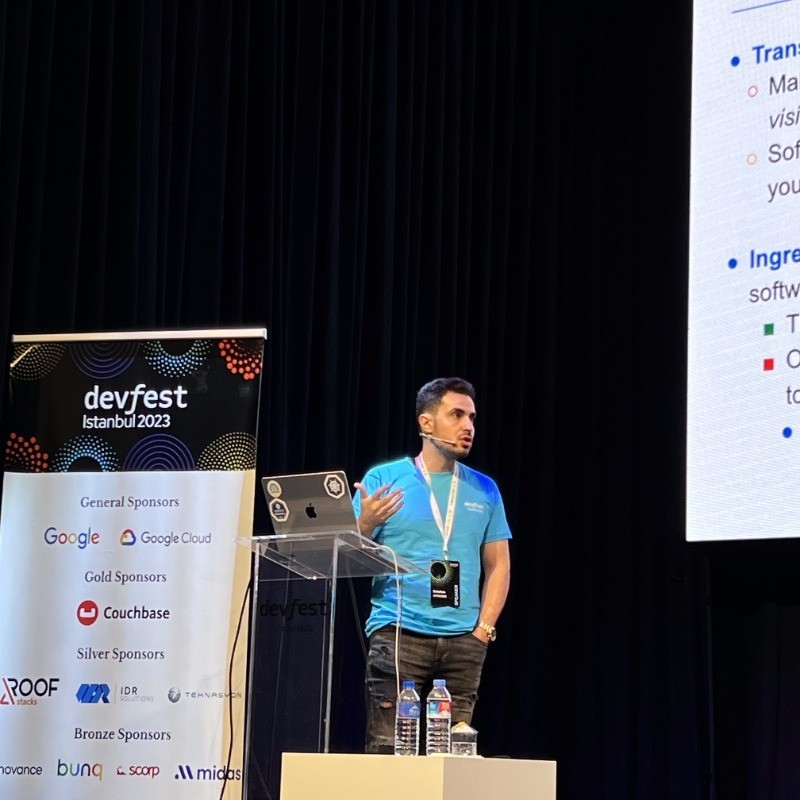
Batuhan Apaydın
I am very happy to share with you a great development today!! Dagger we have established our Istanbul Meetup group as of now! ☝️
One of Dagger Solomon Hykes' newest innovations is to develop a programmable CI/CD engine. 🤖
Dagger is a tool that allows you to develop your CI/CD processes with your favorite programming language that you use to develop your software, and to run your CI/CD steps in containers, eliminating remote engine dependency and advancing all your processes in your local environment. 🚀
The main purpose of this group will be to raise awareness about the Dagger project and to talk about the benefits of this tool for us, you are all invited! 👋
https://lnkd.in/dMNjdBDP
#dagger #daggercommunity #daggeristanbul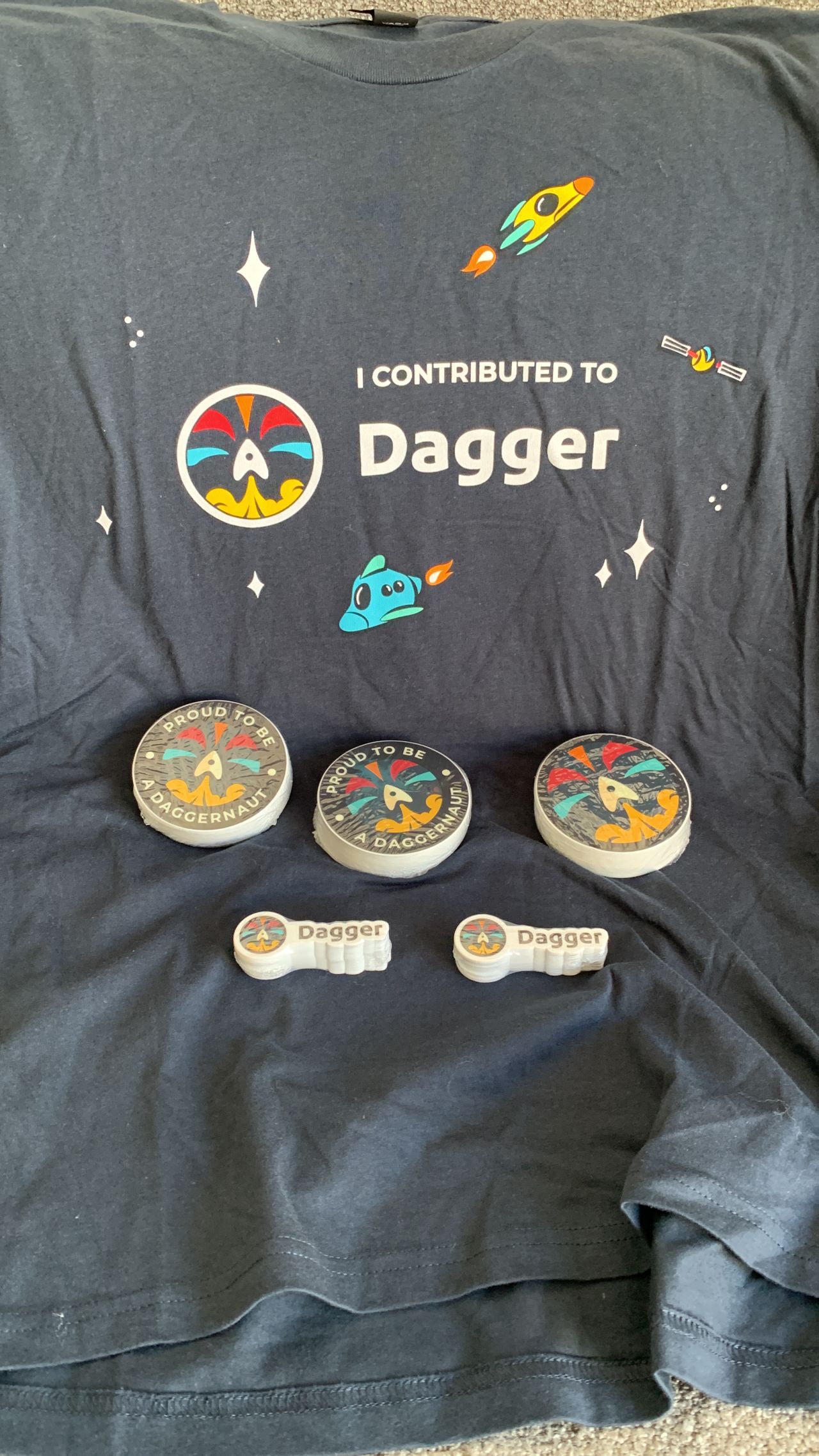

Lee Gaines
Principal Engineer
It's kind of a container-based swiss army knife that can be used for CI operations (reproducible builds, testing, publishing), creating LLM agents, and more. Tons of integrations and open-source modules on the "Daggerverse".

Jordan Parker
When @solomonstre drops an open-source Claude Code... ya run with it. "Toy Programmer" + added MCP & cursor-rules + an updated version of @zbeyens phenom "dotai" repo

Kyle Penfound
This is so awesome to play with. I just made a new frontend for my main demo repo without any hand-holding, writing integrations, or anything. Just core dagger + bring your own LLM. In a 2 minute video. Most of which is for the sake of the recording

Benjie D.
So im finally coming around on this whole AI thing is the future...Solomon Hykes demo of an agent writing a curl clone in 5 minutes using Dagger is still lingering in my mind...if any of you are curmudgeons like me you might want to watch...

Yves
If you don’t know where to start to create AI agents, you should have a look at Dagger agents. That makes it so easy to build tools that will benefit from AI but as real developer tool.

Steeve Morin
Few understand the implications of this. This will be absolutely defining

Alberto Fuentes
I'm feeling a "docker moment" in real time. Even though I didn't know the CI tool, it seems so promising for multiple areas.

Matias Pan
@dagger_io experimental AI tooling is really interesting. I just leveraged two separate modules (Strava and Notify). It took me 20 minutes to build the prompt and less than 5 to write the code.

Ankur Duggal
This is crazy cool! If you have worked with LLMs this is amazing!

Peter Jausovec
all your dagger functions are now available for agents to use. built-in function registry.

Madhav Jivrajani
This is nuts. @dagger_io has always had amazing dev exp, but the fact that it lends itself so seamlessly to something like this is endlessly impressive, massive props @solomonstre and the team!

Austen
Ok, my mind is a little blown right now. I never considered having LLMs accept containers as inputs and then interact with them to accomplish some goal.

Adrian Duermael
CEO at Cubzh
That's why tools like @dagger_io are going to be so powerful! (standardized text interface, multi-language modules and a neatly integrated web GUI over the CLI) Great AI assistant experiences largely depend on well-designed interfaces they can easily leverage.

Steeve Morin
Founder of ZML
I think few realize where Dagger sits in the agentic race. I know I didn’t until I was shown. Incredible.

Corentin Kerisit
If you can relate, you need @dagger_io and fast.

Pedro Piñera
Founder, CEO - Tuist
It’ll take time for people to realize the value of @dagger_io but I’m optimistic it’ll reach critical mass and break the vendor locking that many CI providers benefited from for many years.

Pedro Piñera
Founder, CEO - Tuist
I just tried to set up a CI pipeline using @dagger_io to compile and test an Elixir project and OMG. The portability is so priceless. Blog post in progress 😀

David Flanagan
My entire CI/CD pipeline is Dagger and I'd love for dev to be too; still a few changes that need to happen there though.
Watch this space 😃

Edouard Bonlieu
Co-founder @gokoyeb , deploy apps and databases on high-performance infrastructure around the world. Previously built @scaleway
Excited to hear @solomonstre talking about @dagger_io and Dagger functions. Need to push the @gokoyeb function to the Daggerverse

Zhipeng Huang
Open Source Effectively Accelerates !
It was great to participate @dagger_io Meetup yesterday, one of the purest form of OSS event: no bullshit, minimal slides, maximum code. @solomonstre might gave away his @KubeCon_ KN magic a bit
, but it was really fun.

Diego Ciangottini
Technologist
🚀 My top pick video from hashtag#KubeCon + hashtag#cloudnative in Paris is out! From integrated environments to innovative approaches, there's something for every science community to keep an eye on.
YOU get to choose what we dive into next! Comment with your preference!
https://lnkd.in/d2Xj2DhJ
1️⃣ First up, Kubeflow offers an all-in-one solution for data science workflows on Kubernetes. Check out CERN Computing's experience at the hashtag#cloudnativeAIDay event and the DHL Data & Analytics and their journey to a data science platform.
2️⃣ Impressive NATS.io with a demo by Synadia perfect for applications from hashtag#ai / hashtag#ml on IoT to microservices
3️⃣ Discover Dagger Functions, revolutionizing workflow management for reproducibility and interoperability
Plus, an extra shoutout to the Cloud Native Computing Foundation (CNCF) Enduser Research, let's push it together as it should be!
Dany Camirand
Conseiller intégrateur en architecture logicielle (Cloud/DevOps) chez Ministère de la Famille du Québec (MFA)
What I also like 👌 about Dagger is that it perfectly aligns with my personal fav quote:
'Localhost is your best cloud provider’ 🔥🚀
https://dagger.io
Ivan Velichko
Software Engineer
What Is Dagger and Why You Might Want to Use It 🧵
Dagger promises to fix our CI/CD once and for all, but what exactly is Dagger?
Is it a GitHub Actions or Jenkins replacement? Or is it a dev tool that augments existing CI/CD providers? Is it a service or a CLI?
My take 👇

Utsab Sapkota
DevOps and Cloud
Just finished an incredible hands-on session with Saiyam Pathak, Solomon Hykes, and Kyle Penfound on the Kubesimplify channel, diving deep into the powerful tool Dagger. Followed along on my personal computer and learned a ton. Highly recommend checking it out for anyone interested in cutting-edge DevOps! hashtag#Dagger hashtag#DevOps hashtag#Kubesimplify
https://lnkd.in/dygitKgn
Brian Goff
Senior Software Engineer at Microsoft
I always felt like tools like docker-compose were not the right fit me me. Always required lots of glue to make it work for the things I needed to do.
This is where @dagger_io shines. Far more programatic, testable, and repeatable.

Kyle Galbraith
Co-Founder of depotdev
We released a new version of our @dagger_io Daggerverse module to bring the Depot ephemeral registry to our bake function. Going to be a game changer for building all your images at once and being able to do things with the containers immediately
https://depot.dev/changelog/2024-03-26-depot-daggerverse-1-1-0

Dipankar Das
DevOps engineer at @rtCamp | loves writing code | Founder of @ksctl_k8s
you all got me. Taskfile and Makefile now its dagger @SaiyamPathak. 🙃 Btw nice explanation on dagger. I think its a good tool, used it 1 year ago 😉 @dagger_io


Lev Lazinskiy
Technical GTM Leader
Nothing beats reading a story about Dagger from a real user. Thanks so much to Scott Molinari for sharing your experience :)
https://lnkd.in/d9fQGRg7
Sheldon Hull
expert at spline reticulation. ⚡ AWS Infinidash MVP ⚡ I ❤️ coding. Work as Senior Software Engineer.
Wrapping my head around the new functions thing is going to take a bit. But I've already done nested docker Goreleaser with CGO_ENABLED , angular builds and more with the SDK. So great! Dagger call might take over all my 3 years of mage work once I figure it all out.

John McBride
sr engineer @saucedopen 🥡 prev: AWS, VMware, Pivotal
@sheldon_hull @dagger_io and @MagefileDotOrg We’re starting to adopt dagger actually loving it so far

Neela Jacques
Former Executive Director, OpenDaylight Project, founder VSPP/vCloud @VMware , launched Cilium/Isovalent out of stealth, now helping Solomon grow http://Dagger.io
What a WILD morning! @solomonstre‘s keynote seems to have ignited something major, we’ve been swamped all morning here at @KubeCon_!


BC Gain
DevOps. Security. Observability. Linux. Kubernetes. Sailing. ReveCom Media.
Use @dagger_io to build pipelines input: @chainguard_dev's Building Container Images the Modern Way -
@chainguard_dev' s Adrian Mouat demo. It « real strength » is its modules, he said.
@KubeCon_ @linuxfoundation @thenewstack


Kubecon_
The #Kubernetes & #cloudnative community conference
“It’s all about the people.” - Solomon Hykes #kubecon #cloudnativecon


Daniel Bryant
DevRel/GTM Leader | News/Podcast @InfoQ | Web 2.0 coder, platform engineer, Java Champion, CS PhD | cloud/K8s, APIs, IPAs, running | learner/teacher
An enjoyable look back on the origins of @Docker, containers, and cloud platforms, via @solomonstre
at #KubeCon. And love the call out to “dude, where’s my platform?” Many of us are still working on this with
@dagger_io, @kratixio, #Backstage, and @CloudNativeFdn tech


Rey Lejano
CNCF Ambassador | @kubernetesio 1.23 Release Lead, 1.25 Emeritus Adviser, K8s SIG Docs co-chair | 👨🏻💻 @RedHat
#KubeCon Europe day 3 keynotes with @solomonstre from @dagger_io who helped kick off popularizing #containers and #CloudNative over a decade ago. 16 years ago, the first working build of Docker was created walking distance from #KubeCon Paris


Solomon Hykes
CEO and Co-Founder, Dagger
The recording of my #kubecon keynote is out: https://youtu.be/S_Z4AHZlSUI Thank you to everyone who attended, on the last day of a draining event. It was a special moment that I enjoyed very much, I hope you did too. Non-french speakers: watch this after


Carlos Santana
Sr. Kubernetes Specialist SA @AWSCloud | CNCF Ambassador | Kubernetes contributor
Join me at the first @dagger_io meetup in Raleigh, NC this week. The meetup will start by teaching the basics of Dagger with real-world examples. I'm still in KubeCon mode, looking forward to meeting the DevOps community in person! Check out the event details at https://meetu.ps/e/MWc2l/3Fcx2/i


Melissa McKay
Mom. Software engineer. Author. Java Champion. Docker Captain. Dev Advocate @JFrog
Yeah... ok, there are much better foot models out there than me, but I had to show off the @dagger_io gear I brought with me from #KubeCon Chicago! Thanks for these @jpadamspdx - they were perfect for the long flight home after an incredible week at #KubeCon Paris!


Jordi Mon Companys
PMM @chainguard_dev
@solomonstre surrounded by people at #KubeCon


Dan Lorenc
Software Supply Chain Security
I built my first Dagger function yesterday with Solomon Hykes, and just got it published up on the daggerverse!
Dagger is awesome, and I plan on continuing to find ways to use it. At a high level, dagger lets you use containers as a first-class object in code, and stitch together complex orchestration pipelines using real programming languages instead of bash.
Primitives like mounting in files/directories, running commands, building and publishing containers, environment variables and secrets are all available, type-safe, and programmable in Go, Python, or Typescript.
Dagger functions let you build abstractions and methods on top of these basic primitives that can then be exposed and reused by other Dagger functions. The entire experience is encapsulated by the `dagger` cli, which uses magical buildkit caching and orchestrations so it's all *fassstttt*. You can run it locally or in CI systems and get the same results, and confidence that things will actually work after a push.
As self-described a yamlbash enthusiast, I'm still excited at the thought of replacing those tangled messes with real code.
Check it out here, this version is capable of building Python wheel packages across a variety of Python versions, and can handle installation of extra build-time dependencies too, for when you need some ugly cmake stuff or other native libraries. Also, it uses wolfi and Chainguard images for all the execution and package handling :)
https://lnkd.in/eDBtk7pm
#dagger #ci #opensource #wolfi #chainguard
Miguel Martinez Trivino
Co-founder at chainloop.dev
Chainloop is an Open Source Metadata Vault for your Software Supply Chain metadata, OWASP CycloneDX SBOM/xBOM Standard, SPDX SBOM, VEX, SARIF files, QA reports, and more.
From today, you can programmatically collect and enforce Software Supply Chain pieces of evidence from your Dagger pipeline!
Dagger is a great fit since it is aligned with our principle of meeting developers where they are, and you can’t get closer to them than in code, with their programming language, and in their local machine 🙂
If you want to give it a try in person, we'll also be in a couple of days at #kubecon in Paris. See you there!
Tom Hacohen
Founder & CEO at Svix
I first saw a demo of Dagger two years ago and you could sense something big was brewing.
Now with Dagger functions, it's actually happening. I just saw another demo and it really feels like something we'll all be using!
Congrats Dagger for building something special!

Emmanuel Sibanda
Software Engineer
Dagger is a programmable open source CI/CD engine. I built a Dagger module to solve the "but it works on my machine" problem that occurs where tests that pass locally do not pass in development because of inconsistencies in environment configurations for NodeJS applications. In this blog I detail the entire process; what I learnt through my build along with insights gained from reading Dagger docs and their Python SDK.
#Python #CICD #Jest #NodeJS #DevOps #Frontend

Oleg Šelajev
Testcontainers at Docker. Developer, author, speaker. Java Champion
Feeling productive at #kubecon with @kylepenfound. We just made a @dagger_io module to enable @Testcontainers tests easily.


Jorge Arteiro
Cloud Developer Advocate
The one and only @solomonstre, thanks for been so welcoming. Eternally grateful for everything you did. Go @dagger_io !!!!! At #KubeCon


Darren Shepherd
Chief Architect & Co-Founder
Now that I understand the tao of dagger, I never want to write another dockerfile. But I have too 😢

Tsiry Sandratraina
Building fluentci_io
I finally ported some @fluentci_io modules to @dagger_io Modules


Maria Vechtomova
MLOps Tech Lead | Public speaker
It can take many "git push" to get your #cicd pipeline working.
Arne Mueller and I wrote an article about using Dagger, which you can use to run your pipelines locally and in your #cicd tool of choice:
➡ We walk through a pipeline that does unit testing, Python package building, and Docker image build and push.
➡ We show the implementation of the pipeline defined "old style" in GitHub actions, and explain how you can run it locally with act.
➡ We compare it with implementation using Dagger & very minimalistic GitHub actions.
No more "push and pray 🙏" for your #DevOps and #MLOps engineers!
Check it out on Marvelous MLOps substack: https://lnkd.in/eNcrdCiX.

Vincent Behar
Developer
Today we had @solomonstre at the Ubisoft office - to talk about @dagger_io of course, but also our challenges. And I think he might start prototyping something soon for one of our use cases... how many CEOs do that? ;-) It was great, come back when you want!


Yoofi Quansah
Advocate of better Platforms for Devs
Yeah @dagger_io killed it with writing CI pipelines as code, and being able to run that locally. I can’t think of how else you can get a similar experience except by writing a bunch of bash with Docker.

Flipt.io
There are two ways to ship code: 1. Push and Pray 2. Test, Test, Test, Test We recommend option #2. And use @dagger_io to make your life easy.

Anaïs Urlichs

Mark Robert Coleman
Co-founder & CPO of Netboxlabs
Been spending some time playing with @NetBoxOfficial @go_containerlab and @dagger_io and its pretty amazing how much can be done in the network automation space in what feels like a very cloud native way at the moment. Hoping to package it all up for a demo real soon 🚀 🚀 🚀

Sági-Kazár Márk
Head of OSS @openmeterio | Speaker, tech content creator
@dagger_io community meeting at @fosdem with @sameoldaweris


Noam Elfanbaum
Software developer
@dagger_io has replaced a combination of dockerfiles, docker-compose, and makefiles/bash scripts for me, making it easier to run CI tests locally and in GitHub actions. Great work @solomonstre!

verdverm
Unexpected surprise using @dagger_io Cloud... If you export your key from your local development environment, then all of your local build results are side-by-side with your CI build results. It's pretty great being able to recall why something failed locally and then share it

Vincent Behar
Developer
I just wrote my 1st @dagger_io modules https://github.com/vbehar/daggerverse… and the experience is really nice, thanks to the Dagger CLI. Good job guys!


Mike Elsmore
Developer
@dr4goonis talking about stuff, @dagger_io, and CI/CD at @PHPUKConference
Warning! Live demos! #phpuk24


Romaric Philogène
CEO @Qovery_ - Internal Developer Platform ☁️ | Love to solve engineering problems | Rust 🦀, Kotlin, Go, Python, Java
My latest issue on why I believe @dagger_io could be the future of CI/CD for Engineering and Platform Engineering teams
https://romaricphilogene.substack.com/p/platform-tips-18-dagger-the-future
#platformengineering #cicd #devops #dagger
Batuhan Apaydın
I am very happy to share with you a great development today!! Dagger we have established our Istanbul Meetup group as of now! ☝️
One of Dagger Solomon Hykes' newest innovations is to develop a programmable CI/CD engine. 🤖
Dagger is a tool that allows you to develop your CI/CD processes with your favorite programming language that you use to develop your software, and to run your CI/CD steps in containers, eliminating remote engine dependency and advancing all your processes in your local environment. 🚀
The main purpose of this group will be to raise awareness about the Dagger project and to talk about the benefits of this tool for us, you are all invited! 👋
https://lnkd.in/dMNjdBDP
#dagger #daggercommunity #daggeristanbul

Lee Gaines
Principal Engineer
It's kind of a container-based swiss army knife that can be used for CI operations (reproducible builds, testing, publishing), creating LLM agents, and more. Tons of integrations and open-source modules on the "Daggerverse".

Jordan Parker
When @solomonstre drops an open-source Claude Code... ya run with it. "Toy Programmer" + added MCP & cursor-rules + an updated version of @zbeyens phenom "dotai" repo

Kyle Penfound
This is so awesome to play with. I just made a new frontend for my main demo repo without any hand-holding, writing integrations, or anything. Just core dagger + bring your own LLM. In a 2 minute video. Most of which is for the sake of the recording

Benjie D.
So im finally coming around on this whole AI thing is the future...Solomon Hykes demo of an agent writing a curl clone in 5 minutes using Dagger is still lingering in my mind...if any of you are curmudgeons like me you might want to watch...

Yves
If you don’t know where to start to create AI agents, you should have a look at Dagger agents. That makes it so easy to build tools that will benefit from AI but as real developer tool.

Steeve Morin
Few understand the implications of this. This will be absolutely defining

Alberto Fuentes
I'm feeling a "docker moment" in real time. Even though I didn't know the CI tool, it seems so promising for multiple areas.

Matias Pan
@dagger_io experimental AI tooling is really interesting. I just leveraged two separate modules (Strava and Notify). It took me 20 minutes to build the prompt and less than 5 to write the code.

Ankur Duggal
This is crazy cool! If you have worked with LLMs this is amazing!

Peter Jausovec
all your dagger functions are now available for agents to use. built-in function registry.

Madhav Jivrajani
This is nuts. @dagger_io has always had amazing dev exp, but the fact that it lends itself so seamlessly to something like this is endlessly impressive, massive props @solomonstre and the team!

Austen
Ok, my mind is a little blown right now. I never considered having LLMs accept containers as inputs and then interact with them to accomplish some goal.

Adrian Duermael
CEO at Cubzh
That's why tools like @dagger_io are going to be so powerful! (standardized text interface, multi-language modules and a neatly integrated web GUI over the CLI) Great AI assistant experiences largely depend on well-designed interfaces they can easily leverage.

Steeve Morin
Founder of ZML
I think few realize where Dagger sits in the agentic race. I know I didn’t until I was shown. Incredible.

Corentin Kerisit
If you can relate, you need @dagger_io and fast.

Pedro Piñera
Founder, CEO - Tuist
It’ll take time for people to realize the value of @dagger_io but I’m optimistic it’ll reach critical mass and break the vendor locking that many CI providers benefited from for many years.

Pedro Piñera
Founder, CEO - Tuist
I just tried to set up a CI pipeline using @dagger_io to compile and test an Elixir project and OMG. The portability is so priceless. Blog post in progress 😀

David Flanagan
My entire CI/CD pipeline is Dagger and I'd love for dev to be too; still a few changes that need to happen there though.
Watch this space 😃

Edouard Bonlieu
Co-founder @gokoyeb , deploy apps and databases on high-performance infrastructure around the world. Previously built @scaleway
Excited to hear @solomonstre talking about @dagger_io and Dagger functions. Need to push the @gokoyeb function to the Daggerverse

Zhipeng Huang
Open Source Effectively Accelerates !
It was great to participate @dagger_io Meetup yesterday, one of the purest form of OSS event: no bullshit, minimal slides, maximum code. @solomonstre might gave away his @KubeCon_ KN magic a bit
, but it was really fun.

Diego Ciangottini
Technologist
🚀 My top pick video from hashtag#KubeCon + hashtag#cloudnative in Paris is out! From integrated environments to innovative approaches, there's something for every science community to keep an eye on.
YOU get to choose what we dive into next! Comment with your preference!
https://lnkd.in/d2Xj2DhJ
1️⃣ First up, Kubeflow offers an all-in-one solution for data science workflows on Kubernetes. Check out CERN Computing's experience at the hashtag#cloudnativeAIDay event and the DHL Data & Analytics and their journey to a data science platform.
2️⃣ Impressive NATS.io with a demo by Synadia perfect for applications from hashtag#ai / hashtag#ml on IoT to microservices
3️⃣ Discover Dagger Functions, revolutionizing workflow management for reproducibility and interoperability
Plus, an extra shoutout to the Cloud Native Computing Foundation (CNCF) Enduser Research, let's push it together as it should be!
Dany Camirand
Conseiller intégrateur en architecture logicielle (Cloud/DevOps) chez Ministère de la Famille du Québec (MFA)
What I also like 👌 about Dagger is that it perfectly aligns with my personal fav quote:
'Localhost is your best cloud provider’ 🔥🚀
https://dagger.io
Ivan Velichko
Software Engineer
What Is Dagger and Why You Might Want to Use It 🧵
Dagger promises to fix our CI/CD once and for all, but what exactly is Dagger?
Is it a GitHub Actions or Jenkins replacement? Or is it a dev tool that augments existing CI/CD providers? Is it a service or a CLI?
My take 👇

Utsab Sapkota
DevOps and Cloud
Just finished an incredible hands-on session with Saiyam Pathak, Solomon Hykes, and Kyle Penfound on the Kubesimplify channel, diving deep into the powerful tool Dagger. Followed along on my personal computer and learned a ton. Highly recommend checking it out for anyone interested in cutting-edge DevOps! hashtag#Dagger hashtag#DevOps hashtag#Kubesimplify
https://lnkd.in/dygitKgn
Brian Goff
Senior Software Engineer at Microsoft
I always felt like tools like docker-compose were not the right fit me me. Always required lots of glue to make it work for the things I needed to do.
This is where @dagger_io shines. Far more programatic, testable, and repeatable.

Kyle Galbraith
Co-Founder of depotdev
We released a new version of our @dagger_io Daggerverse module to bring the Depot ephemeral registry to our bake function. Going to be a game changer for building all your images at once and being able to do things with the containers immediately
https://depot.dev/changelog/2024-03-26-depot-daggerverse-1-1-0

Dipankar Das
DevOps engineer at @rtCamp | loves writing code | Founder of @ksctl_k8s
you all got me. Taskfile and Makefile now its dagger @SaiyamPathak. 🙃 Btw nice explanation on dagger. I think its a good tool, used it 1 year ago 😉 @dagger_io


Lev Lazinskiy
Technical GTM Leader
Nothing beats reading a story about Dagger from a real user. Thanks so much to Scott Molinari for sharing your experience :)
https://lnkd.in/d9fQGRg7
Sheldon Hull
expert at spline reticulation. ⚡ AWS Infinidash MVP ⚡ I ❤️ coding. Work as Senior Software Engineer.
Wrapping my head around the new functions thing is going to take a bit. But I've already done nested docker Goreleaser with CGO_ENABLED , angular builds and more with the SDK. So great! Dagger call might take over all my 3 years of mage work once I figure it all out.

John McBride
sr engineer @saucedopen 🥡 prev: AWS, VMware, Pivotal
@sheldon_hull @dagger_io and @MagefileDotOrg We’re starting to adopt dagger actually loving it so far

Neela Jacques
Former Executive Director, OpenDaylight Project, founder VSPP/vCloud @VMware , launched Cilium/Isovalent out of stealth, now helping Solomon grow http://Dagger.io
What a WILD morning! @solomonstre‘s keynote seems to have ignited something major, we’ve been swamped all morning here at @KubeCon_!


BC Gain
DevOps. Security. Observability. Linux. Kubernetes. Sailing. ReveCom Media.
Use @dagger_io to build pipelines input: @chainguard_dev's Building Container Images the Modern Way -
@chainguard_dev' s Adrian Mouat demo. It « real strength » is its modules, he said.
@KubeCon_ @linuxfoundation @thenewstack


Kubecon_
The #Kubernetes & #cloudnative community conference
“It’s all about the people.” - Solomon Hykes #kubecon #cloudnativecon


Daniel Bryant
DevRel/GTM Leader | News/Podcast @InfoQ | Web 2.0 coder, platform engineer, Java Champion, CS PhD | cloud/K8s, APIs, IPAs, running | learner/teacher
An enjoyable look back on the origins of @Docker, containers, and cloud platforms, via @solomonstre
at #KubeCon. And love the call out to “dude, where’s my platform?” Many of us are still working on this with
@dagger_io, @kratixio, #Backstage, and @CloudNativeFdn tech


Rey Lejano
CNCF Ambassador | @kubernetesio 1.23 Release Lead, 1.25 Emeritus Adviser, K8s SIG Docs co-chair | 👨🏻💻 @RedHat
#KubeCon Europe day 3 keynotes with @solomonstre from @dagger_io who helped kick off popularizing #containers and #CloudNative over a decade ago. 16 years ago, the first working build of Docker was created walking distance from #KubeCon Paris


Solomon Hykes
CEO and Co-Founder, Dagger
The recording of my #kubecon keynote is out: https://youtu.be/S_Z4AHZlSUI Thank you to everyone who attended, on the last day of a draining event. It was a special moment that I enjoyed very much, I hope you did too. Non-french speakers: watch this after


Carlos Santana
Sr. Kubernetes Specialist SA @AWSCloud | CNCF Ambassador | Kubernetes contributor
Join me at the first @dagger_io meetup in Raleigh, NC this week. The meetup will start by teaching the basics of Dagger with real-world examples. I'm still in KubeCon mode, looking forward to meeting the DevOps community in person! Check out the event details at https://meetu.ps/e/MWc2l/3Fcx2/i


Melissa McKay
Mom. Software engineer. Author. Java Champion. Docker Captain. Dev Advocate @JFrog
Yeah... ok, there are much better foot models out there than me, but I had to show off the @dagger_io gear I brought with me from #KubeCon Chicago! Thanks for these @jpadamspdx - they were perfect for the long flight home after an incredible week at #KubeCon Paris!


Jordi Mon Companys
PMM @chainguard_dev
@solomonstre surrounded by people at #KubeCon


Dan Lorenc
Software Supply Chain Security
I built my first Dagger function yesterday with Solomon Hykes, and just got it published up on the daggerverse!
Dagger is awesome, and I plan on continuing to find ways to use it. At a high level, dagger lets you use containers as a first-class object in code, and stitch together complex orchestration pipelines using real programming languages instead of bash.
Primitives like mounting in files/directories, running commands, building and publishing containers, environment variables and secrets are all available, type-safe, and programmable in Go, Python, or Typescript.
Dagger functions let you build abstractions and methods on top of these basic primitives that can then be exposed and reused by other Dagger functions. The entire experience is encapsulated by the `dagger` cli, which uses magical buildkit caching and orchestrations so it's all *fassstttt*. You can run it locally or in CI systems and get the same results, and confidence that things will actually work after a push.
As self-described a yamlbash enthusiast, I'm still excited at the thought of replacing those tangled messes with real code.
Check it out here, this version is capable of building Python wheel packages across a variety of Python versions, and can handle installation of extra build-time dependencies too, for when you need some ugly cmake stuff or other native libraries. Also, it uses wolfi and Chainguard images for all the execution and package handling :)
https://lnkd.in/eDBtk7pm
#dagger #ci #opensource #wolfi #chainguard
Miguel Martinez Trivino
Co-founder at chainloop.dev
Chainloop is an Open Source Metadata Vault for your Software Supply Chain metadata, OWASP CycloneDX SBOM/xBOM Standard, SPDX SBOM, VEX, SARIF files, QA reports, and more.
From today, you can programmatically collect and enforce Software Supply Chain pieces of evidence from your Dagger pipeline!
Dagger is a great fit since it is aligned with our principle of meeting developers where they are, and you can’t get closer to them than in code, with their programming language, and in their local machine 🙂
If you want to give it a try in person, we'll also be in a couple of days at #kubecon in Paris. See you there!
Tom Hacohen
Founder & CEO at Svix
I first saw a demo of Dagger two years ago and you could sense something big was brewing.
Now with Dagger functions, it's actually happening. I just saw another demo and it really feels like something we'll all be using!
Congrats Dagger for building something special!

Emmanuel Sibanda
Software Engineer
Dagger is a programmable open source CI/CD engine. I built a Dagger module to solve the "but it works on my machine" problem that occurs where tests that pass locally do not pass in development because of inconsistencies in environment configurations for NodeJS applications. In this blog I detail the entire process; what I learnt through my build along with insights gained from reading Dagger docs and their Python SDK.
#Python #CICD #Jest #NodeJS #DevOps #Frontend

Oleg Šelajev
Testcontainers at Docker. Developer, author, speaker. Java Champion
Feeling productive at #kubecon with @kylepenfound. We just made a @dagger_io module to enable @Testcontainers tests easily.


Jorge Arteiro
Cloud Developer Advocate
The one and only @solomonstre, thanks for been so welcoming. Eternally grateful for everything you did. Go @dagger_io !!!!! At #KubeCon


Darren Shepherd
Chief Architect & Co-Founder
Now that I understand the tao of dagger, I never want to write another dockerfile. But I have too 😢

Tsiry Sandratraina
Building fluentci_io
I finally ported some @fluentci_io modules to @dagger_io Modules


Maria Vechtomova
MLOps Tech Lead | Public speaker
It can take many "git push" to get your #cicd pipeline working.
Arne Mueller and I wrote an article about using Dagger, which you can use to run your pipelines locally and in your #cicd tool of choice:
➡ We walk through a pipeline that does unit testing, Python package building, and Docker image build and push.
➡ We show the implementation of the pipeline defined "old style" in GitHub actions, and explain how you can run it locally with act.
➡ We compare it with implementation using Dagger & very minimalistic GitHub actions.
No more "push and pray 🙏" for your #DevOps and #MLOps engineers!
Check it out on Marvelous MLOps substack: https://lnkd.in/eNcrdCiX.

Vincent Behar
Developer
Today we had @solomonstre at the Ubisoft office - to talk about @dagger_io of course, but also our challenges. And I think he might start prototyping something soon for one of our use cases... how many CEOs do that? ;-) It was great, come back when you want!


Yoofi Quansah
Advocate of better Platforms for Devs
Yeah @dagger_io killed it with writing CI pipelines as code, and being able to run that locally. I can’t think of how else you can get a similar experience except by writing a bunch of bash with Docker.

Flipt.io
There are two ways to ship code: 1. Push and Pray 2. Test, Test, Test, Test We recommend option #2. And use @dagger_io to make your life easy.

Anaïs Urlichs

Mark Robert Coleman
Co-founder & CPO of Netboxlabs
Been spending some time playing with @NetBoxOfficial @go_containerlab and @dagger_io and its pretty amazing how much can be done in the network automation space in what feels like a very cloud native way at the moment. Hoping to package it all up for a demo real soon 🚀 🚀 🚀

Sági-Kazár Márk
Head of OSS @openmeterio | Speaker, tech content creator
@dagger_io community meeting at @fosdem with @sameoldaweris


Noam Elfanbaum
Software developer
@dagger_io has replaced a combination of dockerfiles, docker-compose, and makefiles/bash scripts for me, making it easier to run CI tests locally and in GitHub actions. Great work @solomonstre!

verdverm
Unexpected surprise using @dagger_io Cloud... If you export your key from your local development environment, then all of your local build results are side-by-side with your CI build results. It's pretty great being able to recall why something failed locally and then share it

Vincent Behar
Developer
I just wrote my 1st @dagger_io modules https://github.com/vbehar/daggerverse… and the experience is really nice, thanks to the Dagger CLI. Good job guys!


Mike Elsmore
Developer
@dr4goonis talking about stuff, @dagger_io, and CI/CD at @PHPUKConference
Warning! Live demos! #phpuk24


Romaric Philogène
CEO @Qovery_ - Internal Developer Platform ☁️ | Love to solve engineering problems | Rust 🦀, Kotlin, Go, Python, Java
My latest issue on why I believe @dagger_io could be the future of CI/CD for Engineering and Platform Engineering teams
https://romaricphilogene.substack.com/p/platform-tips-18-dagger-the-future
#platformengineering #cicd #devops #dagger
Batuhan Apaydın
I am very happy to share with you a great development today!! Dagger we have established our Istanbul Meetup group as of now! ☝️
One of Dagger Solomon Hykes' newest innovations is to develop a programmable CI/CD engine. 🤖
Dagger is a tool that allows you to develop your CI/CD processes with your favorite programming language that you use to develop your software, and to run your CI/CD steps in containers, eliminating remote engine dependency and advancing all your processes in your local environment. 🚀
The main purpose of this group will be to raise awareness about the Dagger project and to talk about the benefits of this tool for us, you are all invited! 👋
https://lnkd.in/dMNjdBDP
#dagger #daggercommunity #daggeristanbul
Build workflows that build software.

Build workflows that build software.

Build workflows that build software.

Build workflows that build software.

Join Our Engineering Deep Dive on Agentic CI
Join Our Engineering Deep Dive on Agentic CI
Community
Community
Join the community
Connect, learn, and share with fellow engineers and builders.








